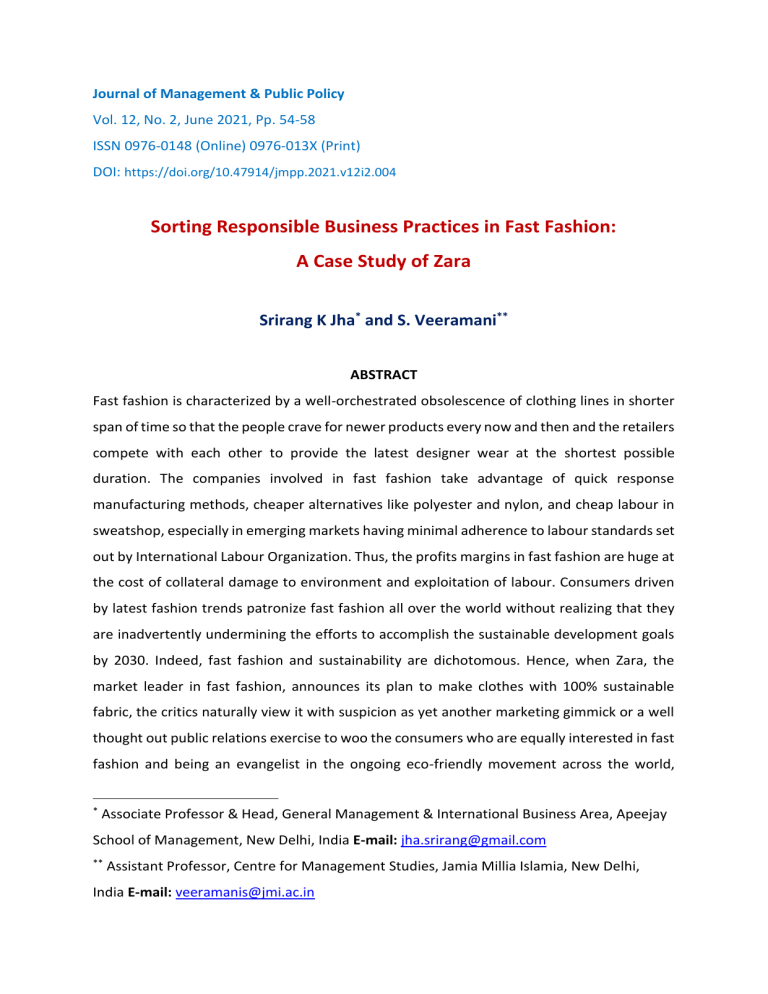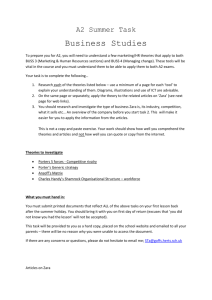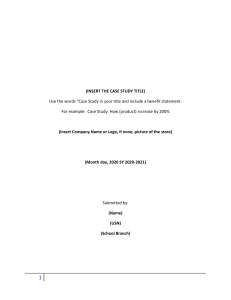
Journal of Management & Public Policy Vol. 12, No. 2, June 2021, Pp. 54-58 ISSN 0976-0148 (Online) 0976-013X (Print) DOI: https://doi.org/10.47914/jmpp.2021.v12i2.004 Sorting Responsible Business Practices in Fast Fashion: A Case Study of Zara Srirang K Jha* and S. Veeramani** ABSTRACT Fast fashion is characterized by a well-orchestrated obsolescence of clothing lines in shorter span of time so that the people crave for newer products every now and then and the retailers compete with each other to provide the latest designer wear at the shortest possible duration. The companies involved in fast fashion take advantage of quick response manufacturing methods, cheaper alternatives like polyester and nylon, and cheap labour in sweatshop, especially in emerging markets having minimal adherence to labour standards set out by International Labour Organization. Thus, the profits margins in fast fashion are huge at the cost of collateral damage to environment and exploitation of labour. Consumers driven by latest fashion trends patronize fast fashion all over the world without realizing that they are inadvertently undermining the efforts to accomplish the sustainable development goals by 2030. Indeed, fast fashion and sustainability are dichotomous. Hence, when Zara, the market leader in fast fashion, announces its plan to make clothes with 100% sustainable fabric, the critics naturally view it with suspicion as yet another marketing gimmick or a well thought out public relations exercise to woo the consumers who are equally interested in fast fashion and being an evangelist in the ongoing eco-friendly movement across the world, * Associate Professor & Head, General Management & International Business Area, Apeejay School of Management, New Delhi, India E-mail: jha.srirang@gmail.com ** Assistant Professor, Centre for Management Studies, Jamia Millia Islamia, New Delhi, India E-mail: veeramanis@jmi.ac.in Journal of Management & Public Policy, Vol. 12, No.2, June 2021 which is no less than a fad. This case study examines the responsible business practices at Zara to figure out how far fast fashion can contain its adverse impact on the environment. KEYWORDS: Fast Fashion, Sustainability, Responsible Business Practices, Zara INTRODCUTION Zara is market leader in fast fashion. Over the years, it has mastered the arts and science of providing whatever the consumers want in shortest possible time. Zara takes just two weeks to bring a designer clothing line from studio to its own front stores. No other competitor has been able to match its turnaround time so far. The fashion brand, which is owned by Inditex, has almost 3,000 stores in 96 countries, with new stock arriving every week to keep consumers coming back for more (Jorndan, 2021). The first Zara store was set up in 1975 at a small place called A Coruna in Galicia, Spain. Since its inception, the company swears by its core values i.e., beauty, clarity, functionality and sustainability. Zara has tried to live up to its core value of sustainability by means of company’s stated policies towards water, climate change and energy, biodiversity and above all, closing the loop. Zara has translated its commitments towards sustainability into reality by reorienting its operational strategies, creating eco-friendly stores, and drafting and implementing robust policy frameworks to ensure that environmental issues are not compromised at any cost. Zara has accomplished 100% eco-efficient stores in 2020. The company does not use plastic bags in any of its stores. All the Zara stores have containers for collection of used clothes for the purpose of recycling. The company has also implemented one of the best wet processes in its supply chain as part of its zero discharge commitments. The company is using 100% certified forest-friendly fibers as part of its canopy commitments. The company wants to attain zero waste on all its locations and facilities, use of 100% cellulosic fibers, and 100% of all packaging materials collected for reuse or recycling in our supply chain by 2023. Further, the company has set an ambitious target of attaining 80% of renewable energy in all its facilities (headquarters, logistics and stores), 100% sustainable cotton (organic, BCI and/or recycled cotton), 100% recycled polyester, 100% sustainable linen by 2025. All the designers of Zara have been trained and specialized in circularity. All the initiatives aimed at sustainability taken by Zara are quite reassuring so far as the responsible business practices of Zara are concerned. 55 Journal of Management & Public Policy, Vol. 12, No.2, June 2021 Responsible Business Practices at Zara Zara demonstrates its commitment towards all the stakeholders. Table 1 provides the measures adopted by Zara to protect the interests of various stakeholders. Continuous exchange of ideas and transparency are the essential principles that govern Zara’s relations with its stakeholders (Inditex, 2015). The company has a well-structured mechanism to ensure compliance to its corporate social responsibility policy in terms of ethics committee, audit and control committee, social advisory board, code of conduct and responsible practices, code of conduct for manufacturers and suppliers, and disclosure (Inditex, 2015). Indian arm of Zara is equally committed to global best practices in responsible business adopted by the parent company Inditex (Zara, 2015). Zara in India focuses on lives and livelihood augmentation as part of its social commitments. In Indian context, Zara is involved in promoting education, employment enhancing vocation skills and livelihood enhancement projects especially among children, women, elderly and the differently abled in addition to promoting gender equality, empowering women and senior citizens, and undertaking measures for reducing inequalities faced by socially and economically backward groups (Zara, 2015). Zara measures impact of all its social initiatives on a regular basis through a number of objective methods including the London Benchmarking Group (LBG) measurement methodology. Some of the responsible business practices have been noticed even by the critics. For example, Zara is successfully running ‘closing the loop’ programme which enables the customers to deposit their old clothes at any of the stores across the world for recycling purpose besides using recycled bags (Dockrill, 2020). Disclosure and reporting of Zara regarding corporate social responsibility and sustainability are also commendable (Dockrill, 2020). Zara is known for publishing report on its suppliers in terms of forced labour, gender equality, freedom of association, etc. (Dockrill, 2020). CRITIQUE A close look at Zara’s responsible business practices however reveal that not everything is fine with the company. Business model of Zara itself is detrimental to sustainability. Zara encourages as well as induces its customers world over to go for unmindful consumption by 56 Journal of Management & Public Policy, Vol. 12, No.2, June 2021 offering latest designs almost every fortnight. Such a consumption pattern results in phenomenal profits for Zara but harms the planet earth irreparably. The brand releases an incredible 24 trend-led collections every year, 500 designs a week and almost 20,000 per year, which in turn leads consumers to see their clothes as disposable and adds to even more waste from the garment industry that ends up in landfill (Jordan, 2021). Indeed, Zara’s fast fashion business model can never be environmentally friendly as manufacturing so many new garments create huge amounts of waste every year. This goes some way to explain why the average American is estimated to throw away 37kg of clothes each year, 85% of which will end up in landfill or be burned (Jordan, 2021). Dockrill (2020) has listed following issues that expose the magnificent responsible business practices edifice of Zara: “Although Zara has set an absolute target to reduce greenhouse gas emissions generated from its own operations and supply chain, there is no evidence it is on track to meet its targets. Further, there is no evidence that it minimizes textile waste when manufacturing its products. Zara has made little or no progress on payment of living wages across its supply chain. For a company with such a huge profit margin, this simply is not good enough. Half of its final stage of production is undertaken in Spain, a medium risk country for labour abuse, and the brand received a score of 51-60% in the Fashion Transparency Index. Zara does use wool, leather, and exotic animal hair and there is no evidence that it traces any animal products to the first stage of production.” CONCLUSION Zara has certainly made a mark as socially responsible business house. Yet, a lot is desired from the market leader in the fast fashion industry. The company needs to focus on improving the labour standards across its supply chain and bring in operational efficiency in implementing its corporate social responsibility and sustainability policies. REFERENCES Dockrill, M. (2020). How ethical is Zara? Good on You: https://goodonyou.eco/how-ethicalis-zara/ 57 Journal of Management & Public Policy, Vol. 12, No.2, June 2021 Inditext. (2015). Corporate social responsibility policy: https://www.inditex.com/documents/10279/240918/Inditex+Sustainability+Policy.pdf/7cfc 197b-ec03-7ea6-757c-df7406262cdc Jordan, D. (2021). Is Zara ethical and sustainable? https://wear-next.com/news/is-zaraethical-or-sustainable/ Zara. (2015). Corporate social responsibility policy of Inditex Trent Retail India Private Limited: https://www.zara.com/static/pdfs/IN/csr_policy/CSR_India_Policy_20151117.pdf Table 1: Measures adopted by Zara to Protect Interests of the Stakeholders [Adapted from Inditext (2015)] 58




